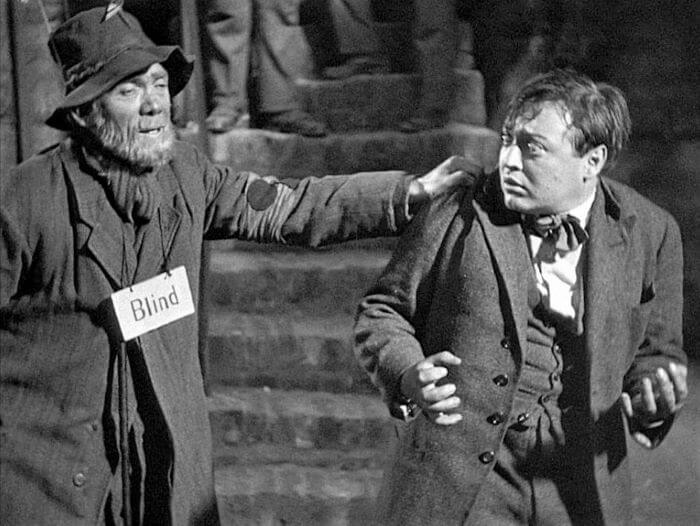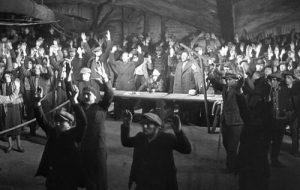Last updated on November 4th, 2023 at 07:23 pm
M is a 1931 German crime thriller film directed by Fritz Lang and starring Peter Lorre as a child murderer named Hans Beckert. The film, which was Lang’s first sound film, tells the story of Beckert’s pursuit by the police and the criminal underworld, who come together to capture him before he kills again. The film was a critical and commercial success and is considered a classic of German expressionist cinema.
Based on German social crime involving child abduction and killing, M film 1931 is an outstanding creation of the German Film Industry. M-1931 is a story about a psychopathologist murderer of children. In German, M denotes Mörder or Murderer, who kills out of compulsion. The thriller film displays a pathologically disturbed man’s thirst for offending and killing children just because he cannot help it. Girl children were the most victims.
As a part of watching the 101 best films of 100 years, I have finished watching another magnum opus or masterpiece, the M-1931 film, created by Austrian-German-American filmmaker Fritz Lang, an expressionist who was known as the master of darkness. The film was released in 1931 and is one of the classics.
The M-1931 shows how a criminal is nabbed by another organized criminal organization while the police and homicide forces jointly were able to procure only obscure public witness accounts without any clear-cut leads even after multiple children went missing.
Even though public security is widely expected by the general people of all sects, public cooperation in curbing crimes cannot be availed every time. In order to have a secure and vibrant society, public cooperation is invaluable. However, ‘mob justice’ merely represents justice as hardy get any time to identify the actual crimes and criminals.
Fuelled by a rumour of child lifting, an angry mob stood guard and made a few victims of mob lynching across the country. The phenomenon went so out of control that it took the Bangladesh government a few months to bring the situation under control. The rumour related to child lifting in Bangladesh cost 826 lives, from 2011 to 2019, among which the killing of Renu is much talked about and waiting for justice.

Having said that, the film revealed a few very crucial aspects of society, that, when the government fails to protect people and nab the criminals and award rightful treatment, the mob sentiment and police everyone is a prospective criminal. Simple, law-abiding citizens can become easy victims of mob vigilante which has happened recently in Bangladesh.
The film also exposed a very pertinent matter which can be seen as a flaw in justice but an important sinew of a democratic polity that everyone deserves to be defended, even if someone is a criminal; and cannot be condemned anyone as a criminal if his crimes are results of psychological deformity.
The way Elsie Beckmann’s mother waited anxiously for her daughter to return home from school, repeatedly observed the hands on the grandfather clock on the wall was preparing the table for her daughter for lunch, asked the postman and her classmates who have just returned from school and she called for her daughter opening the window are unforgettable.
M-1931:
Storyline
A pregnant woman was climbing up carrying a basket upstairs while a few children are playing an elimination game in the basement humming a song, “Just you wait, it won’t be long. The man in black will soon be here with his cleaver’s blade so true. He’ll make mincemeat out of you”!
Sinister as it sounds, she did not like the contents of their song, and the children were reprimanded. She handed over the basket to Frau Beckmann, mother of a little schoolgirl, Elsie Beckmann, who was preparing lunch for her daughter.

After school, Elsie crossed the road with the help of security personnel. Playing with a ball, instead of heading home, she approached a huge column of the building on which a poster says, “10,000 marks rewards, who is the murderer?
Little Kurt Klawitzky and his sister Klara have been missing since June 11. Evidence leads us to believe the children were victims of a crime similar to that committed last fall against the Doering siblings”.
Following Elsie, Hans Beckert, the murderer, remarked, “What a pretty ball you have there. What is your name?”. “Elsie Beckmann”, says little Elsie.
Hans Beckert whistled and bought Elsie a balloon from a blind street vendor. He lured her, and took her away. Presumably, Elsie was killed leaving no trace. Her balloon was seen stuck with telephone ware while the ball was found in a deserted area.
Then Hans Beckert writes to the press: “Because the police did not publish my first letter, I am writing now directly to the press. Proceed with your investigation. All will soon be confirmed. But I am not done yet”!
A long conversation between the Police Commissioner and Minister follows:
Police commissioner: “Mr. Secretary, we cannot stop the murderer from writing to whoever he wishes. This severely pathological man probably takes great pleasure in seeing his crime covered in the press. We immediately got in touch with the press. And have them ask to send us the original letter.
Secretary: we know commissioner you are doing your works and your men too, but we need results.
The Police Commissioner said, “My men haven’t gotten 12 hours’ sleep in an entire week! My riot squads don’t get a moment’s of peace. They report for duty almost more fatigued than when they were dismissed, because the painstaking nature of their work wears on their nerves, and 80%, if not 90% of our leads are false.
The homicide squad doesn’t even get time to change clothes. They are constantly on call always tense and alert. Ever ready to spring into action, to follow even the slightest lead, as it just might be the one that solves the case.
Mr. Secretary, consider the search of the crime scene. To give you an example, in the bushes just behind a picket fence, a small, white crumpled paper wrapping was found. It was once contained inexpensive sweets. In the outermost corner were found traces of fruit drops and particles of powdered sugar.
We have tried to trace the origin of this wrapper in every candy shop and grocery store within a radius of a mile and a half but to no avail. With each passing day, we expand the area searched.
But of course, after such a long time, no one remembers anything that could serve as a lead. Despite all these setbacks, we are forced to press on in our investigation, always in uncertainty and with little chance of success in bringing the case even one step closer to its conclusion. Our men are doing everything”.
Angry, Sectary replied, “What good is all that? Commissioner, I am aware you’re not dawdling, but that does not change the fact that an unknown killer is terrorizing four and a half million people! And the police are getting nowhere”!
Calmed, Commissioner said, “Mr. Secretary, you don’t seem to have a clear picture of the enormous obstacles confronting our forces. Do you realize for example, regarding the route the child took home, that there are fifteen conflicting eyewitnesses’ accounts alone? Let me give you a random example: “Testimony 1478 in the Beckmann murder case’. In their hunt for this unknown killer, the police have tracked down more than 1500 detailed leads.”
He adds, “The files, in this case, fill 60 thick volumes. We have dispatched all our forces to systematically comb the area adjoining the city. Every piece of undergrowth is secured, every bush examined, since any bush or hollow could harbour some object that could finally set us on the right track.
We called in police dogs. We set the best trackers on the faintest of traces but they lost the scent and failed to pick it up again despite all efforts.
Since the first murders, the police have searched homeless shelters night after night, subjecting everyone in them to thorough scrutiny. This does not, of course, make the police very popular, nor does it reduce the general public’s anxiety. The railway station is kept under surveillance around the clock. Still, the investigation has not yielded the slightest results. Nor have nighty raid in the criminal’s districts”.
The police raids unleashed public outrage. The arrest took place indiscriminately. The woes of the general public mounted as people who failed to produce papers faced police interrogation.
In the meantime, graphologists discovered that the killer is a strongly pathological sexuality of sex offender. Partial disrupts and uneven style of handwriting in the letter reveal a form of acting that is related to external lethargy. The graphologist said that “the writing as a whole, displays elusive yet unmistaken signs of madness”.
Because of frequent police raids to their businesses and indiscriminate interrogation of police in searching for the murderer, the city’s organized criminal activities were hampering. Their prostitutions were raided. Their movements were followed.
Considering their decreasing business the underworld organization’s members realized that if this manhunt continues they will all be broke soon. Without the police’s knowledge, they decided to catch Hans Beckert themselves and hand him over to the police in order to bring their business to normalcy.
During the meeting with the minister regarding public cooperation, Inspector Lehmann said, “I will tell you about the public cooperation! Just thinking of it makes me puke. What the devil has the public cooperation gotten us so far? They alert homicide whenever a chimney sweep walks by. But when you really want reliable information from them, then they suddenly haven’t got a clue. Why, they just can’t seem to remember a thing. There’s your public cooperation for you!”
Most of the public still takes the position, “How does this concern me?” The idea that each individual is responsible for what happens to the poorest, most anonymous child on the street hasn’t even dawned on the public at large!
The difficulties in solving crimes of this nature are, in my experience, often insurmountable, says another inspector, “since perpetrator and victim are often brought together by mere chance. The instincts of the moment drive the murderer’s actions. It’s a fact well-known to all of us that murderers like this rarely leave a clue behind. That’s what makes our work so hard, our successes so few.”
The underground criminals already have planned to catch the murderer in disguise. They employed informants on police and children’s movements in the city. The police and homicide squad are also ready to search meticulously every resident, landlord, and property owner for the slightest clues. They were looking for the place from where the letter came and with it a wooden table and a red pencil with which the murderer wrote the letter to the press.
The criminals hired the entire beggar organization in the city and appointed them at various points to check the movement of the children and the murderer.
Meanwhile, a list of reports from every public and private institute, municipal hospital and asylum of mental patients who have been cured and released came to homicide squad inspector Lehmann, with their addresses.
And the police started following leads according to the addresses. They eventually found the traces of red pencil and discovered that the letter was written not on the table but on the window ledge.
While the police were in search of leads, criminals were trying to track the murderer down, the other day Hans Beckert noticed a girl inside a store through storefront glasses and wanted to lure her. With the compulsive instinct, he started following the girl with the mouth whistle playing but could not succeed as her mother came on time to fetch her.
Disappointed, he went to the nearby bar and had two cognacs. The roadside blind balloon vendor heard his whistling and was reminded of what had happened to Elsie Beckmann the last time when he heard that. Sensing something sinister the blind man cried out for help from a friend of his, who came quickly in response.
The blind man asked him if he could see the man who was whistling. He said he still can see him but has stopped whittling and started talking to a girl. The balloon seller told him not to lose sight of him as he remembered the last time he bought balloons and gave it to little Elsie before she was lured and killed.
The man tracked him down inside a store buying things for a little girl. But he remained hidden when the murderer came out of the store. He then wrote the letter M on his palm with a piece of chalk. Then just as a pedestrian he walked past the killer and pretended to be bumped into him, and pasted the letter on the upper back of the killer’s shoulder without his knowledge about it.
The hired beggars now are following the sign M on his shoulder after a telephone call from the informant, while the members of the criminal organization started following his footsteps as well.
Ambushed, and surrounded, Bans Beckert realized his apprehensiveness. Frightened by the presence of criminals he ran to the office building and took refuge inside the attic. The beggars surrounded the building and asked for help from Safecracker. They decided to break him out of the building.
At night at 11 pm, they started their operation in the building before the police had known about the murderer’s whereabouts. Tying up the watchmen of the apartment, the members of the criminal organization invaded the building in search of the murderer, Bans Beckert.
During their raid, in the middle of the casualty, a watchman was able to send a signal to the police station which left the criminals with little time to catch the murderer. Anyhow, they caught and put him inside a sack and brought him out before the police reached the spot. But they left behind Franz, the man who was still busy making a hole through the ceiling.
Nevertheless, the police are still unaware of the murderer, while Franz did not reveal anything during interrogation with the police about the man that they were looking. The police did not know where he was taken.
Later, in custody, Franz agreed to tell everything about the child murder to homicide squad inspector Karl Lehmann. He told him that Bans Beckert was taken to a building deserted after the Great Depression of the 1930s.
Inside the building, the murderer was taken to face a Kangaroo Court trial with hundreds of lawyers present, including the criminals and Safecracker, the leader of the criminal organization. There Bans Beckert asked for better treatment and a prosecutor.
And a prosecutor indeed spoke for him, “If I were you, I wouldn’t make big speeches. Your head’s at stake here, in case you hadn’t noticed. I have the dubious pleasure of serving as your defence. Though I’m afraid it won’t do you much good”, says the lawyer.
“I demand to be handed over to the police. I demand to be brought before a real court of law”, cried Beckert!
“You’d like that, wouldn’t you?” replied Safecracker, “So you can plead insanity and spend the rest of your life being cared for by the state. And then you break out of the asylum or receive a pardon, and you’re happy as can be, free to kill with impunity, protected by law on grounds of insanity and you’re back to chasing little children! No, no more of that!”
“I can’t help it!” protested the Bans Beckert, “I really can’t…help it! Can I do anything about it? Don’t I have this cursed thing inside me? This fire, this voice, this agony? I have to roam the streets endlessly, always sensing that someone’s following me. It’s me! I’m shadowing myself! Silently…but I still hear it! Yes, sometimes I feel like I’m tracking myself down. I want to run, run away from myself! But I can’t!
I can’t escape from myself! I must take the path that it’s driving me down and run and run down endless streets! I want off! And with me run the ghosts of the mothers and children. They never go away. They’re always there! Always! Always! Except when I’m doing it. When I… Then I don’t remember a thing. Then I’m standing before a poster, reading what I’ve done. I read and read… “
“I did that? I don’t remember a thing! But who will believe me? Who knows what it’s like inside me? How it screams and cries out inside me when I have to do it! Don’t want to! Must! Don’t want to! Must! And then a voice cries out, and I can’t listen anymore! Help! I can’t”.
Beckert’s prosecutor objected to Safecracker, “My learned colleague who just spoke, who is, if I’m not mistaken, wanted by the police on three counts of manslaughter, has claimed that the fact that my client was acting compulsively warrants the death sentence. He is mistaken because the very nature of compulsion warrants an acquittal! It is precisely the nature of compulsion that relieves him of responsibility for his actions! And a man cannot be punished for that for which he is not responsible!”
“I’m saying that this man is sick, and you turn a sick man over to a doctor, not an executioner. No one has the right to kill a man who cannot be held responsible for his crimes.” continues, the prosecutor.
He further adds, “Not even the state, and all of you least of all! The state must ensure that this man is rendered harmless so that he ceases to be a danger to society! I will not let you shout me down! I will not allow a murder to be committed in my presence. I demand that this human being be afforded the same protection under the law rendered the common criminal! I demand that he be handed over to the police!
Disregarding the prosecutor’s stand for the law while all were about to dawn on the murderer to kill all of a sudden all raised their hands up. Surprised, before he understood anything someone grabbed his shoulder and pronounced, “In the name of the law”.
During the prosecution in the court of law, the mothers of the deceased children were lamenting saying, “This will not bring our children back. One has to keep a closer watch over the children! All of you”.
M-1931 ends with an unresolved mystery of whether the murderer was tried or ended up in an asylum, the way Safecracker presumed during the trial.
However, the film talks more about the failure of the state-sponsored justice system which often and usually fails the victims and seekers of justice. Over complexities, weak public prosecution, corruption, and cronyism eroded the system to the very core.
Personal Opinion
If M film has to talk about the contemporary justice system of Germany in the 30s, it is more relevant to our failed justice system in Bangladesh. Along with more than 4 million pending cases in Bangladesh, the aftermath of a criminal case was clearly realized by Safecracker.
In his retort to Beckert’s appeal for him to be handed over to the police, he said, “So you can plead insanity and spend the rest of your life being cared for by the state. And then you break out of the asylum or receive a pardon, and you’re happy as can be, free to kill with impunity, protected by law on grounds of insanity and you’re back to chasing little children!”
Our justice system is either too complex or too costly that the state fails its citizens of justice. In the 1972 film The Godfather, we see how a man can rise up to become an underworld godfather secure justice to those who are incapable of it or failed by the state.
On the other hand, when the state steps forward to hand the case on behalf of the victims, the process is so complex, strenuous, and costly that the victims eventually away from seeking justice. Victims are helpless, scattered, and penniless but not lawless, while criminals are organized, united, and capable but lawless.
M film 1931 quotes
Sure you can catch the pickpockets, why don’t you catch the murderer instead?
Put enough dogs on the fox’s tail.
Don’t snore you will awake lice.
No one has the right to kill a man who cannot be held responsible for his crimes! Not even the state, and all of you least of all! The state must ensure that this man is rendered harmless so that he ceases to be a danger to society!
I will tell you about the public cooperation! Just thinking of it makes me puke. What the devil has the public cooperation gotten us so far?
They alert homicide whenever a chimney sweep walks by. But when you really want reliable information from them, then they suddenly haven’t got a clue.

